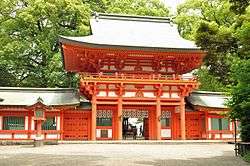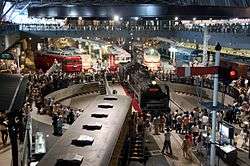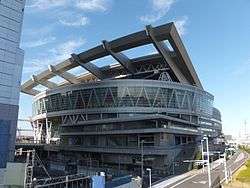Saitama
Saitama (さいたま) is the capital of Saitama prefecture in the Kanto region of Japan. It came into existence after the merging of 4 former cities, including Urawa, the former capital, in 2001. Upon its creation, it became the tenth most populous city in the nation and the only capital city with its name written in hiragana instead of Chinese characters.
Understand
Tourist office
- Omiya station, ☎ +81 48-644-1144, fax: +81 48-647-8778. Daily 9:00AM-19:00PM.
- Urawa station, ☎ +48-600-0070, fax: +48-600-0070. Daily 10:00AM-18:30PM.
- Shintoshin district, Chūō-ku, Kamiochiai 2, ☎ +48-883-1055, fax: +48-883-1055. Daily 10:00AM-18:30PM.
Get in
By plane
The closest major international airport is Narita.
A tiny number of JR Narita Express trains serve at Omiya Station -- as of this writing, the 17:16 and 18:48 NEX departures from NRT T1 terminate at Omiya, and Omiya has two originating NEX services at 6:21 and 9:09. When it is available the NEX is fairly fast, taking around 110 minutes. At other hours, you can make it to Ōmiya station by taking the Narita Express to Tokyo and changing to the Tohoku/Joetsu Shinkansen; either route is covered by the Japan Rail Pass or JR East Pass.
JR Kanto Bus runs limousine bus service, the O N Liner, every hour from Narita Airport to and from the Saitama Shintoshin and Ōmiya train stations. The trip takes about two hours and costs ¥2750 each way.
The cheapest way to travel from Narita Airport to Omiya is to take a Narita Sky Access commuter train to Shin-Kamagaya station and change to the Tobu Noda Line. This takes about the same amount of time as the bus but only costs ¥1580.
From Haneda Airport you can take the Keikyu line to Shinagawa station and change to the JR Keihin-Tohoku line for the run to the Saitama area (80-90 minutes to Omiya, ¥1020). Hourly limousine buses also run to Ōmiya station (90 minutes, ¥1500).
By train
Saitama's Ōmiya Station (大宮駅) is a major train hub, connecting together the Tohoku Shinkansen and Joetsu Shinkansen lines, as well as the JR Keihin-Tohoku Line, JR Tohoku (Utsunomiya) Line, JR Takasaki Line, JR Saikyo Line, JR Kawagoe Line, JR Shonan-Shinjuku Line and Tobu Noda Line.
|
Why do shinkansen trains travel from Tokyo to Omiya in nearly the same time as local trains? While bullet trains in the north are capable of speeds up to 275 km/h (165 mph), trains between Tokyo and Omiya are limited to 110 km/h (65 mph) due to residential noise restrictions. |
- Just about all northbound shinkansen trains from Tokyo and Ueno stop at Ōmiya station, with the ride from Tokyo taking 25 minutes. A reserved seat costs ¥2800, and a non-reserved seat, ¥1580, making the ride quite uneconomical compared to a local train. However, if you have a Japan Rail Pass or JR East Rail Pass, your trip is covered. Departures every 5-15 minutes. (Note: If you do decide to make this peculiar journey, note that seating is all-reserved on the Hayate and Komachi bullet trains.)
- Regular trains on the Tohoku and Takasaki lines run from Ueno to Ōmiya in 25 minutes at a cost of ¥450. These trains make added stops at Saitama Shintoshin Station (さいたま新都心駅), near the Saitama Super Arena. Service every 10 minutes or less.
- The Keihin Tohoku Line is a local service connecting Ōmiya and Saitama Shintoshin to eastern Tokyo, including from Tokyo station (50 minutes, ¥540), Shinagawa (one hour, ¥620) and Kawasaki (75 minutes, ¥780). Service every 10 minutes or less.
- There is also service from western Tokyo to Ōmiya via the Saikyo Line and the Shonan-Shinjuku Line. Trains leave from Ikebukuro (25-35 minutes, ¥380), Shinjuku (30-40 minutes, ¥450) and Shibuya (30-40 minutes, ¥540). Service every 10 minutes or less.
- The Shonan-Shinjuku Line is also the best way of reaching Ōmiya from Yokohama (one hour, ¥890). Service runs every 10-20 minutes. Keihin-Tohoku Line local trains make the same run in 80-90 minutes, departing every 10 minutes or less.
- The Tobu Noda Line links Ōmiya station with Kasukabe (connection to the Tobu Isesaki Line), Kashiwa (connection to the JR Joban Line), Shin-Kamagaya (connection to the Narita Sky Access Line and Shin-Keisei Railway) and Funabashi (connection to the Keisei Line and JR Sobu Line).
Get around
Most of the attractions are within walking distance of one of the city's train stations, but there are Community Buses with routes throughout the city.
See
- 🌍 Saitama Museum of Modern Art (埼玉県立近代美術館 saitama-kenritsu kindaibijutsukan), ☎ +81 48-824-0111. 10AM-5:30PM. A museum of modern art featuring works by famous painters, such as Monet, Picasso, and Chagall. ¥200 (special exhibits have separate fees).

- 🌍 Hikawa Shrine (氷川神社 hikawa jinja). One of the most important Shinto shrines in the Kanto area, claiming the history of more than two thousand years. Take the train to JR Omiya station, exit to the east, and keep walking until you come to the tree-lined street. This is the two-kilometer long entrance path to the shrine. Turn left and walk straight north until you reach Hikawa Shrine itself. On New Year's Day, people young and old come to visit and celebrate the new year. Next to the shrine is a park, Omiya Koen.
- 🌍 Saitama Prefectural Museum of History and Folklore (埼玉県立歴史と民俗の博物館). Exhibits artifacts from around Saitama Prefecture with information about its history and culture.

- 🌍 Railway Museum (鉄道博物館), 3-47 Onaricho (Saitama New Shuttle Tetsudo-hakubutsukan Stn, one stop from JR Omiya). Open Wed-Mon 10 AM-6 PM. A must of rail buffs and great for kids, the museum features 36 engines on display (including Japan's first steam locomotive), train cab simulators, Japan's largest HO-gauge miniature railway and more. You can even eat your lunch in a restored dining car. English language signage is sparse. ¥1000/500 adult/child.
- 🌍 Sōji-in (総持院), ☎ +81 48-878-1545. A temple famous for its garden of hundreds of peonies which bloom from the end of April through the beginning of May.
- 🌍 Tōgyoku Doll Museum (東玉人形の博物館 tōgyoku ningyō no hakubutsukan), 3-2-32 Hommachi, Iwatsuki-ku, ☎ +81 48-756-1111. Tōgyoku dolls are a famous local product and symbol. According to legend, a priest named Esho became sick while passing through the area. Although he recovered from the illness, it weakened him to the point that he couldn't leave the town. He began to pass the time by making dolls out of the local wood. His dolls slowly grew in popularity and the tradition of doll-making has been a part of the Iwatsuki area ever since. They were given the name 'Tōgyoku' by a local lord when he was given one of the dolls as a present. The museum has many examples of these dolls, as well as exhibits of other types of dolls. They also have workshops where you can make your own dolls for a fee. ¥300.
- 🌍 Urawa Art Museum (うらわ美術館 urawa bijutsukan). 10AM-5PM. The museum collects and displays art of and from books. They also aim to foster local artists by featuring their works. Free, except special exhibitions.
- 🌍 Jion-ji (慈恩寺). The 12th temple of the Bandō 33 Temple Pilgrimage.
Omiya Bonsai Village
The Omiya Bonsai Village (大宮盆栽村) is home to a handful of bonsai nurseries which moved here from central Tokyo following the great Kantō earthquake in 1923, they moved to this leafy suburb due to the easy access to fresh water. It's considered to be the 'Bonsai Capital' of the world. Visitors can roam around and visit each of the nurseries. Some bonsai can also be purchased. Pictures are not permitted.
- 🌍 Omiya Bonsai Art Museum (大宮盆栽美術館). 9AM-4:30PM (4PM in winter). An informative museum with exhibits about the various types of bonsai, themes they represent, and how they are trained. The museum includes English explanations and brochures, so you can learn a lot about this traditional Japanese art form without knowing Japanese. ¥300.
- 🌍 Fuyō-en (芙蓉園), 96 Bonsai-cho, Kita-ku. This bonsai nursery nearest Omiya Koen serves as the garden of the president of the Japanese Bonsai Association.
- 🌍 Kyūka-en (九霞園), 131 Bonsai-cho, Kita-ku. Established in 1929 by Kyūzō Murata, the caretaker of the imperial bonsai collection. The founder has now passed away,
- 🌍 Seikō-en (清香園), 268 Bonsai-cho, Kita-ku.
- 🌍 Mansei-En (蔓青園), 268 Bonsai-cho, Kita-ku.
- 🌍 Tōju-en (藤樹園), 247 Bonsai-cho, Kita-ku.
- Shōsetsu-en (松雪園), 640 Higashiōnarichō, Kita-ku.
Note that a museum at the Saitama Super Arena dedicated to John Lennon closed permanently at the end of September 2010.
Do

- 🌍
Ōmiya kōen (大宮公園). The park has a long history. It is the first prefectural park in Saitama. In 1989, a second park was added and in 2001, a third park. As a result, it became the very big park. There is a small zoo in the park. There is a swimming pool, amusement park, soccer field, museum and archery ground, too. It is park that is enjoyable for all ages. When it is spring, many people do cherry-blossom viewing there.
- 🌍 Omiya Park Zoo (大宮公園小動物園). 10AM-4PM. A small children's zoo, home to a variety of birds, monkeys, squirrels, reptiles, and other small animals. Free.
- 🌍 Saitama Super Arena (さいたまスーパーアリーナ). A multi-configuration arena that can seat up to 37,000 people. Numerous shops, restaurants and attractions can be found within. A pedestrian walkway links the Saitama Shintoshin train station with the Super Arena. It's a very big hall. Many famous artists often give concerts there. The person who lives in Saitama does ceremony of Coming of Age Day there every year in January. There is a square around the Saitama Super Arena. It's a good place for a date. On Christmas, a lot of people come, because of the beautiful lights.
- 🌍 Saitama Arts Theatre (さいたま芸術劇場). The city's primary performing arts theatre. Throughout the year, they hold orchestral concerts, piano concerts, plays, musicals, and other events. It has even been used to film dramas. There is also a cafeteria and restaurant on site.
Buy
- 🌍 Red Voltage (レッドボルテージ), ☎ +81 48-824-0290. 10AM-7PM. This is the official souvenir shop for the Red Voltage soccer team.
- 🌍 AEON Mall (イオンモール), ☎ +81 48-856-7100. 9AM-10PM. Large mall complex.
- 🌍 Urawa Corso (浦和コルソ), ☎ +81 48-824-5555. 10AM-8PM (restaurants open until 9:30PM). A mall with a variety of shoes and clothing shops, as well as some specialty shops.
- 🌍 Sweets Shop Ogawaya (御菓子司 小川屋), ☎ +81 48-664-2844. 9:30AM-6PM. Famous sweets for Bonsai Monaka (盆栽最中)and Ōmiya Poppo (大宮ぽっぽ).
Eat
Jumangoku Manjuu is a famous brand of cake from Gyōda, Saitama. Manjyuu is a Japanese-style bun that stuffed with bean paste. Some department stores and souvenir stores such as Sogo department in Omiya station always sell it. One manjyuu is ¥105.
- 🌍 The Three Little Lambs (3匹のひつじ), ☎ +81 48-645-4129. A delicious lamb shabu-shabu restaurant which also serves lamb sashimi or lamb yakiniku. With drinks you can have a delicious, filling meal for under 3000 yen.
- 🌍 Total Kitchen (トータルキッチン), ☎ +81 48-653-9207. Home to Saitama's very own Sweets Gyoten Gyoza, a sweet gyoza with a potato and rice flour base. They also serve a variety of other Japanese dishes, like ramen and soba.
- Torikukai Yakitori bar and grill, 6-26--9 Tozuka Kawaguchi Saitama (About 6 min walk from Tozuka angyo station off the Nanboku line in Saitama), ☎ +81 48-294-5200. During the week master Suzuki san grills up the freshest chicken and on weekends the best ramen using the freshest chicken for a wonderful broth. During the week at dinner its a Yakitori bar with a friendly lively local crowd. 5000 yen for a dinner for two depending on how much you drink and its all top quality cooking.
Drink
- 🌍 The King George Tavern (キングジョージ、大宮), 2-51 Tokai Biru B1, Omiya-ku, ☎ +81 4 8649 5040. 5PM-1AM. A few minutes walk through the seedier side of Saitama from Omiya Station's East Exit. Turn right at the exit and then left down the brightly lit strip full of touts and hostesses in evening dresses. The King George is a way down on your right. This English-style pub is often full of expat English teachers, and hosts a lot of gigs and live events. Drinks are around ¥600.
- 🌍 The HUB (HUB大宮東口店). From Omiya Station (East Exit) and take your first left. Walk for about a half a KM north until you will see the bar on your right. Every gaijin loves a Hub, and this one is arguably the best in the Kanto region, thanks to its massive interior and patio, as well as a non-smoking section that actually stays smoke-free. Food also available in addition to drinks.
Sleep
- 🌍 Pioland Hotel (パイオランドホテル), ☎ +81 48-648-0010. Singles from ¥7900.
- 🌍 Business Hotel Shinpuso, ☎ +81 48-641-4734. Check-in: 4:30-10PM, check-out: 10AM.
- 🌍 Chateau Briant.
- 🌍 Royal Pines Hotel.
Connect
Go next
| Routes through Saitama |
| Nagano ← Takasaki ← Honjō-Waseda ← Kumagaya ← | N |
→ Tokyo Ueno → Tokyo |
| Niigata ← Takasaki ← Honjō-Waseda ← Kumagaya ← | N |
→ Tokyo Ueno → Tokyo |
| Sendai ← Oyama ← | N |
→ Tokyo Ueno → Tokyo |
| Utsunomiya ← Oyama ← | N |
→ Akabane (Tokyo) → Ueno |
| Fuchuhonmachi ← Nishi Kokubunji ← Higashi Tokorozawa ← | W |
→ Shin Koshigaya → Shin Misato → Shin Matsudo |
| Utsunomiya ← Tatebayashi ← Kuki ← | N |
→ into Shutokō Expwy → Tokyo |
| Oizumi(Nerima) ← Wako ← Toda-Minami ← | W |
→ Kawaguchi → Misato |
| END ← | N |
→ Toda → in to |
| Hachioji ← Kawagoe ← | W |
→ Kasukabe → Kashiwa |
| Takasaki ← Kumagaya ← Ageo ← | N |
→ Toda → Warabi → Itabashi |